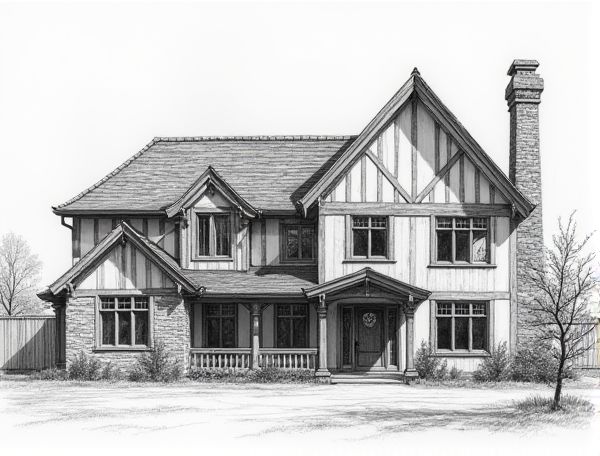
Photo illustration: Tudor home design with original leaded glass windows
Tudor home design is renowned for its charming original leaded glass windows that add timeless elegance and intricate detail to your living space. Discover how incorporating these distinctive features can transform your home's character by reading more in the article.
Introduction to Tudor Home Design
Tudor home design features steeply pitched gable roofs, decorative half-timbering, and tall, narrow windows that create a distinctive medieval English appearance. Your home can embody historic charm and timeless elegance by incorporating these iconic architectural elements.
Historical Origins of Tudor Architecture
Tudor architecture originated in England during the late 15th to early 17th centuries, characterized by its distinctive half-timbered facades, steeply pitched gable roofs, and elaborate masonry chimneys. This style reflects the transition from medieval Gothic elements to Renaissance influences, incorporating ornamental wooden beams and leaded glass windows that emphasize craftsmanship and historical heritage.
Defining Features of Tudor Homes
Tudor homes are characterized by steeply pitched gable roofs, decorative half-timbering, and tall, narrow windows with small panes that create a distinct medieval English appearance. You will notice massive chimneys often adorned with intricate brickwork, contributing to their authentic historic charm. These design elements emphasize craftsmanship and timeless elegance, making Tudor homes a sought-after choice for traditional home design.
Significance of Original Leaded Glass Windows
Original leaded glass windows enhance a home's architectural authenticity by preserving historic craftsmanship and intricate design details unique to specific eras. These windows improve natural light diffusion and provide energy efficiency benefits while adding distinctive aesthetic value and increasing overall property worth.
Craftsmanship Behind Leaded Glass Windows
The intricate craftsmanship behind leaded glass windows involves meticulously cutting and shaping colored glass pieces, which are then assembled using lead cames to create stunning patterns and imagery. Skilled artisans utilize traditional techniques alongside modern tools to ensure durability and aesthetic precision, enhancing light diffusion and adding a unique visual texture to interior spaces. This meticulous attention to detail not only preserves historic artistry but also elevates contemporary home design through bespoke decorative elements.
Aesthetic Appeal and Visual Impact
Your home design should prioritize aesthetic appeal by incorporating balanced color schemes, harmonious textures, and cohesive architectural elements that create a visually stunning environment. Strategic use of natural light, focal points like statement furniture, and well-chosen art pieces can elevate the visual impact, transforming your space into an inspiring and inviting sanctuary.
Benefits of Preserving Original Leaded Glass
Preserving original leaded glass in your home maintains historical authenticity and enhances the aesthetic value by showcasing intricate craftsmanship unique to the period. Your investment is protected through increased property value and improved energy efficiency when the glass is well-maintained and sealed properly.
Maintenance Tips for Leaded Glass Windows
Proper sealing and regular cleaning with a mild, non-abrasive solution help preserve the intricate beauty of leaded glass windows. You should inspect the lead came joints annually for any signs of cracking or separation to prevent moisture damage. Applying a protective wax coating can further enhance durability and maintain the stained glass's vibrant colors over time.
Modern Tudor Home Renovations and Restorations
Modern Tudor home renovations blend classic half-timbered exteriors with contemporary open-concept interiors, enhancing both aesthetic appeal and functionality. Restoration projects prioritize preserving original elements like steeply pitched roofs and leaded glass windows while upgrading insulation and energy-efficient systems for sustainable living.
Enhancing Home Value with Authentic Tudor Details
Incorporating authentic Tudor details such as exposed timber framing, steeply pitched gable roofs, and leaded glass windows significantly enhances a home's value by adding historic charm and architectural authenticity. These distinctive features appeal to buyers seeking character-rich properties, resulting in higher market appreciation and competitive resale potential.
 homedesy.com
homedesy.com